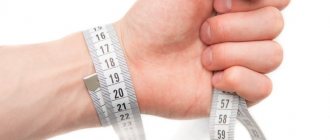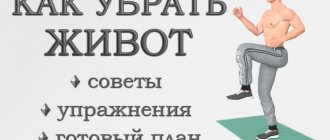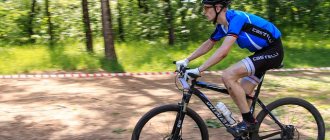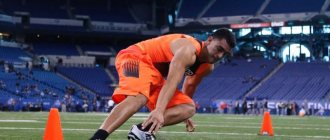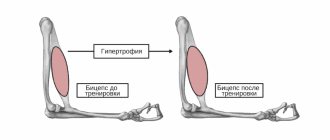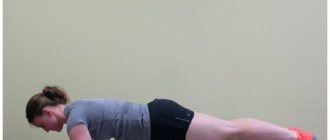- July 21, 2018
- Health
- Katerina Pchelnikova
The physical qualities of a person are understood as the totality of his biological and mental characteristics, which ensure active, purposeful activity. They are laid down by nature, but tend to develop. Each person manifests itself differently and only when solving motor problems. In this article we will understand what the physical qualities of a person are, what their indicators and developmental characteristics are.
Introduction
One of the main tasks solved in the process of physical education is to ensure the optimal development of the physical qualities inherent in a person. Physical qualities are usually called innate (genetically inherited) morphofunctional qualities, thanks to which physical (materially expressed) human activity is possible, which is fully manifested in purposeful motor activity. Basic physical qualities include muscle strength, speed, endurance, flexibility and agility.
As for the dynamics of changes in indicators of physical qualities, the terms development and education are used. The term development characterizes the natural course of changes in physical qualities, and the term education provides for an active and targeted impact on the growth of physical quality indicators.
In modern literature, the terms physical qualities and physical (motor) abilities are used. However, they are not identical. In the most general form, motor abilities can be understood as individual characteristics that determine the level of a person’s motor abilities.
The basis of a person’s motor abilities is physical qualities, and the form of manifestation is motor skills and abilities. Motor abilities include strength, speed, speed-strength, motor-coordination abilities, general and specific endurance. It should be remembered that when it comes to developing muscle strength or speed, this should be understood as a process of developing corresponding strength or speed abilities.
The development of motor abilities is also influenced by psychodynamic drives (properties of psychodynamic processes, temperament, character, features of regulation and self-regulation of mental states, etc.).
A person’s abilities are judged not only by his achievements in the process of learning or performing any motor activity, but also by how quickly and easily he acquires these abilities and skills.
Abilities manifest themselves and develop in the process of performing any activity, but this is always the result of the joint actions of hereditary and environmental factors. The practical limits to the development of a person's abilities are determined by factors such as a person's life expectancy, methods of education and training, etc., but are by no means inherent in the abilities themselves. It is enough to improve the methods of education and training so that the limits of development of abilities immediately increase.
To develop motor abilities, it is necessary to create certain conditions for activity, using appropriate physical exercises for speed, strength, etc. However, the effect of training these abilities also depends on the individual speed of reaction to external loads.
Kinds
The human body, as is known, develops unevenly (or heterochromically). Thus, during childhood, some physical qualities manifest themselves more intensely than others. Experts call this a sensitive time, when competent pedagogical influence is necessary for harmonious development.
There are only 5 physical qualities of a person. These include: speed, agility, strength, endurance and flexibility. They are due to aspects of heredity and development. The first is associated with human physiology, the functioning of his nervous system and energy capabilities. The second requires attention from the person himself and is associated with his desire to develop physical capabilities. Let's take a closer look at each quality.
Psychological characteristics of physical qualities
Sports capabilities are determined by the physical, sports-technical and tactical abilities, as well as the special knowledge and experience of the athlete. At the present stage of development of the theory of physical education, five main physical qualities are distinguished: speed, strength, endurance, agility and flexibility. These physical qualities have their own psychological characteristics: speed is a person’s ability to perform motor actions in the minimum period of time for these conditions. From a psychological point of view, speed is the ability to control the temporary signs of movement, a reflection in the athlete’s mind of the duration, tempo and rhythm of movement. Speed is critical in the sprinting and jumping disciplines of athletics and cycling. It forms the basis of success in most sports games. The speed guarantee depends on three main components.
Mobility of nervous processes: only with a very rapid change in excitation and inhibition and corresponding regulation of the neuromuscular system can a high frequency of movements with optimal application of force be achieved; The duration of the perception process, that is, the transmission of information and the onset of a reaction, underlies the speed of the motor reaction.
Willpower - achieving the highest possible speed depends to a certain extent on the conscious act of exerting effort on yourself.
Coordination factors of the central nervous system influence the frequency of movements to a certain extent. But the speed of individual movement depends no less on them. Coordination factors (of the central nervous system) include a set of coordination mechanisms of the central nervous system for controlling the muscular apparatus and mechanisms of intramuscular and intermuscular coordination.
The mechanisms of intramuscular coordination determine the impulse of the motor neurons of a given muscle: their number, frequency and relationship in time. Intermuscular coordination is responsible for selecting synergistic muscles (necessary for activity) and limiting the activity of antagonist muscles (unnecessary for activity).
With the help of coordination factors, in particular, the contractile forces of muscles (muscle groups) corresponding to the peak speed of movement (action) are regulated.
These forms of speed manifestation are independent of each other. Each of them has its own characteristics, which exist in time parameters.
In the first type of manifestation of speed, one should take into account the time spent by the athlete to begin the action in response to a certain irritation known to him, for example, the start sound signal (shot from the starting pistol, referee's whistle). In this case, the latent time of the motor reaction will be the time spent by the athlete perceiving the sound signal, processing the information received, and transmitting the impulse to action as a response to the stimulus. The end of this process is the moment at which the athlete’s physical activity begins.
The speed of individual movement is characterized by the mental organization of a single action. If a person's walking consists of many repeated movements (steps), then one step is a separate movement. The speed of one step is the speed of a single movement. The speed of steps is, accordingly, the frequency of movements.
Strength is a person’s ability to perform actions with a certain muscle tension. For most sports, this is one of the most important physical qualities. But each of these types has different requirements for strength. Strength, being one of the components of the structure of physical capabilities, determines the performance of an athlete. Strength is closely related to endurance and speed. Speed, strength and strength endurance are the most typical strength characteristics in sports, while absolute muscle strength can be considered as a factor of performance ability and as a measure for assessing the proportion of maximum strength in a particular competitive activity.
Maximal strength is the maximum force that the neuromuscular system can produce during maximal voluntary muscle contraction. It determines achievements in sports in which it is necessary to overcome significant resistance (weightlifting, artistic gymnastics, various types of wrestling). Much of the maximum strength combined with high muscle contraction rate or endurance is also required in hammer throwing, putting, canoeing, etc. The lower the resistance to overcome and the more dominant the rate of muscle contraction or endurance, the lower the importance of maximum strength for athletic performance. Thus, maximum strength is more important to achieve in track and field sprinting than in distance running.
Velocity force is the ability of the neuromuscular system to overcome resistance at high speeds of muscle contraction. Speed strength is critical for achievement in many acyclic and mixed movements (athletics, ski jumping, sports games), in sports where performance depends on the speed of the push, throw or take-off to complete the jump. Velocity force has a significant impact on the performance of certain cyclic movements. It forms the basis for the speed of a sprinter-athlete, a sprinter-cyclist, the ability to accelerate hockey players and football players, etc.
Strength endurance is the body's ability to resist fatigue during prolonged strength work. Strength endurance is characterized by a combination of relatively high strength abilities with significant endurance and determines achievements, primarily when it is necessary to overcome great resistance for a long time. These qualities are manifested in sports such as rowing, cross-country skiing and swimming.
The manifestation of strength (as a physical quality) is based on the activity of the neuromuscular apparatus, and the following prerequisites are met: 1) activation of the executive system (peripheral neuromuscular apparatus); 2) implementation of the muscle activity regime (nerve centers that control muscle activity; contractile apparatus of muscle fibers; electromechanical communication systems of muscle fibers).
Usually, when we talk about human muscular strength, we are talking about maximum voluntary force. After all, if we talk about strength, then the implementation of muscular action occurs with voluntary effort and the desire to contract the necessary muscles as much as possible.
Controlling muscles to show strength is a very difficult task for the central nervous system. It has been proven that maximum voluntary force is always lower than maximum muscle force, which depends on the number of muscle fibers and their thickness. The difference between the values of these strength parameters is called strength deficit. The more perfect the central control of the muscular apparatus, the smaller the power deficit. Its value depends on three factors:
Factor one (psychological). In some emotional states, a person can exhibit such strength that far exceeds his maximum capabilities under normal conditions.
The second factor (the number of muscle groups simultaneously involved). It is known that, under the same conditions, the magnitude of the power deficit is greater, the greater the number of simultaneously contracting muscle groups.
Third factor (degree of perfection of voluntary control). Its role has been proven by many different experiments.
In order for an athlete to develop significant muscle strength during a competitive exercise, he needs to improve voluntary muscle control and, in particular, the mechanisms of intramuscular coordination during training, as well as determine the most optimal methods and means of psychological influence for organizing the emotional state that contributes to maximum manifestation of strength. This can be achieved through the systematic use in the training process of exercises that require the manifestation of great muscle strength (at least 70% of the athlete’s maximum voluntary strength) with the simultaneous solution of tactical problems (achieving a specific goal).
Most often, force is manifested in movement (dynamic force). The athlete’s efforts are not always accompanied by movement; in this case, we should talk about a static mode of work (static force).
Strength is characterized by limiting, distributed and dosed muscle efforts:
- Maximum muscular effort occurs when an athlete demonstrates their full strength. Conscious control is difficult, since the maximum manifestation of muscle efforts is limited by the functional capabilities of the athlete.
- Distributed muscle efforts are efforts of 1/2, 1/4 or 2/4 of the maximum force, subject to conscious control.
- Dosed muscular efforts are efforts that require strict differentiation in their manifestation. They ensure the accuracy of motor actions (in basketball this is throwing the ball into the basket, in boxing - hitting, etc.) and are subject to complete conscious control.
- Endurance is a person’s ability to perform an activity for a long time without reducing its effectiveness.
In everyday speech, the term endurance is used in a very broad sense. Endurance refers to a person’s ability to continuously perform one or another type of mental or physical activity. The characterization of endurance as a human motor quality is very relative. This is a certain type of activity. In physical education, endurance refers to the body's ability to fight muscle fatigue.
Endurance is specific: it manifests itself in each person when performing a certain type of activity, therefore a distinction is made between general and special endurance. General endurance refers to the ability to perform prolonged work that uses many muscle groups and places high demands on the cardiovascular and respiratory systems.
Endurance in relation to a specific activity chosen as a subject of specialization is called special. There are as many types of special endurance as there are types of sports specialization (strength, speed, jumping, etc.).
The manifestation of endurance is always associated with the concept of overwork. Fatigue is the subjective experience of signs of fatigue. This occurs either as a result of overwork of the body, or as a result of monotony of work. To develop endurance, it is important to develop in athletes a positive attitude towards the feeling of fatigue and teach psychological techniques to overcome it.
In sports, as a rule, endurance is the ability to perform long-term global muscular work of a predominantly (sometimes exclusively) aerobic nature. All aerobic exercises of a cyclic nature (easy running from 1500 m, race walking, road cycling, cross-country skiing, swimming at a distance of 400 m, etc.) can serve as an example of sports exercises that require endurance.
In the process of increasing endurance, in addition to changes in the structural-functional, oxygen-transport, oxygen and other physiological systems, the formation of the central nervous and neurohumoral (endocrine) regulation of the activity of these systems occurs. In practice, means and methods of endurance training are usually selected according to the expected physiological effect. But mental factors also need to be taken into account.
Some experimental data show that with continuous long-term interval loads, fundamentally different demands are placed on the volitional qualities of an athlete. It is known that without strong-willed qualities, the manifestation or development of endurance is impossible. In this regard, there are certain psychological recommendations for choosing methods of endurance training. Continuous long-term loads develop volitional qualities that are important for a stayer’s endurance. In this case, the athlete overcomes internal and external difficulties with evenly strong, sustainable willpower.
Interval loads require and develop impulsive concentration of volitional efforts. The athlete overcomes difficulties with relatively short but intense repeated efforts. The manifestation of will is impulsive, interval-changing in nature. Consequently, interval training develops volitional effort of a certain structure, which is necessary for achievements in discrete exercises and is ineffective for achievements in long-term competitive exercises.
Observations show that the volitional qualities necessary for competitions must be developed by adequate training methods and means. There are many different ways to perform endurance training tasks. The development and increase of endurance can be carried out according to the principle of continuous long-term work, interval work and according to the competitive principle.
It should be noted that for each athlete there are rational boundaries of tasks corresponding to the state of his fitness, which change along with the increase in the performance of his body. The value of the tasks must be constantly compared with the individual capabilities of the athlete. This process is supported through monitoring of achievements and training programs.
Agility is a person’s ability to quickly learn new movements and quickly restore motor activity in accordance with the demands of a changing environment. In this case, the object of cognition is movements and actions performed with maximum accuracy of spatial, temporal and force parameters. Among physical qualities, agility occupies a special place from a psychological point of view. It appears only in combination with other physical qualities. Agility is a special quality that manifests itself differently in different sports. A person may have a high degree of skill in gymnastics, but not enough for sports games. Dexterity is closely related to motor skills and is therefore the most complex in nature.
According to conventional wisdom, agility is, firstly, the ability to master complex motor coordination; secondly, sports movements and their improvement; thirdly, in accordance with the changing environment, quickly and rationally restructure your actions.
As is known, V.M. Zatsiorsky offers several criteria for dexterity that allow us to quantify this ability: 1. Difficulty in coordinating a motor task. 2. Accuracy of execution (correspondence of spatial, temporal and power characteristics to the motor task). 3. Mastery time (training time required by the athlete to master the required accuracy of movement or to correct it).
In sports characterized by rapid changes in activity conditions and large variability of actions, it is important to reduce the time between the signal to perform and the start of movement. In a fast-paced environment, great agility is required to respond quickly, expediently and consistently. Here, the ability to adapt quickly (resourcefulness) can serve as a measure of agility.
Agility is an important prerequisite for the development and improvement of sports technique and is therefore of paramount importance in sports where high demands are placed on coordination of movements. It plays an important role in sports that require the ability to adapt to rapidly changing competitive situations (sports games). This dexterity is manifested in the correct selection of previously acquired skills and conscious correction of movements.
Dexterity is also needed for reactive movements, when an athlete needs to reflexively (instantly) restore disturbed balance (in the event of a collision, slipping, etc.).
In sports psychology, it is customary to distinguish between general agility (manifested in various areas of sports activity) and special agility (the ability to master and variably use sports equipment).
Agility, as noted above, can only be demonstrated in combination with other physical qualities. This is one of the main prerequisites for the development of dexterity - human physical capabilities.
Another prerequisite that influences the development of agility is the range of movements. Each movement studied is partially based on old, already developed coordination combinations, which together with new ones form a new skill. The more subtle, precise and varied the activity of the motor system, the greater the athlete’s supply of conditioned reflex connections, the more motor skills he has, the easier he learns new forms of movements, better adapting to existing and changing ones. operating conditions, the greater his dexterity..
The activity of the analyzers is the third main prerequisite for the development of dexterity. Along with the specific role of previously acquired motor experience, the processing of current information (visual, auditory, kinesthetic, tactile and vestibular signals) plays a large role in the development and manifestation of dexterity. Up-to-date current information is perceived by analyzers. Generalized data from all analyzers allows you to study the movement process in more detail, providing a more accurate analysis of it in order to quickly master it and, if necessary, rebuild it.
Everything indicates how great the dependence of dexterity is on the functionality of the central nervous system. The formation of dexterity in sports involves the development of the following skills: 1) quickly master complex motor actions in coordination; 2) rearrange motor activity in accordance with the requirements of the changing environment; 3) clearly perceive spatial, temporal and force parameters of movement.
Flexibility (joint mobility) is the property of elastic extensibility of body structures (muscular and connective), which determines the range of movement of body parts.
The degree of joint mobility is determined primarily by the shape of the joints and the conformity of the articular surfaces. The extensibility of joint ligaments, tendons, and the strength of the muscles around a particular joint determine what range of actions an athlete can use. The elasticity (stretchability) of ligaments can be increased through systematic exercises. However, taking into account the fact that the ligamentous apparatus must perform a protective function, such an increase is possible only to a certain extent. An athlete's flexibility is limited primarily by muscle elasticity. The essence of this limitation is as follows: in various exercises, contraction of certain muscles is accompanied by stretching of their antagonists. During movements with maximum amplitude, mobility in the joints depends on the ability of the antagonists to stretch sufficiently, and it should be remembered that there is a certain limit to their ability to return to the starting position, so special exercises when training flexibility must be combined with strength exercises. An athlete's strength is an important component of flexibility training.
Indicators of active flexibility are characterized not only by the ability of antagonist muscles to stretch, but also by the strength of the muscles performing the movement.
So, flexibility is determined by the elastic properties of ligaments, joints, muscles, the structure of the joints, the strength characteristics of the muscles and, most importantly, the regulation of the central nervous system. Because of this, real indicators of flexibility depend on a person’s ability to combine voluntary relaxation of stretched muscles with tension in the muscles producing the movement. In addition, it should be noted that flexibility has a fairly strong relationship with other physical qualities.
Development of flexibility is impossible without corresponding development of muscle strength. At the same time, greater mobility in the joints helps to increase accuracy, coordination and speed of motor actions. An athlete with more joint mobility can perform movements with greater strength, expressiveness and ease.
What are coordination abilities?
Such abilities are associated with the ability to control movements in space and include:
- spatial orientation;
- dynamic and static balance;
- accuracy of reproduction of certain movements in terms of strength, time and spatial parameters.
Spatial orientation is the preservation of ideas about changes in external conditions or existing situations. This element also implies the ability to rearrange motor actions in accordance with existing changes. At the same time, the athlete must not just react to the external environment. He is obliged to take into account its dynamics of change and make a forecast of upcoming events, and only on the basis of this build his program of action, which is aimed at achieving the required result.
Reproduction of temporal, power and spatial parameters of movements, as a rule, is manifested in the accuracy of the execution of certain motor processes. Their development is carried out by improving sensitive mechanisms.
Static balance manifests itself when the athlete maintains certain poses for a long time. As for the dynamic, on the contrary, it is characterized by maintaining the direction of movements with continuously changing poses.
Means and methods of developing strength
Strength is the ability to overcome or resist external resistance through muscle tension.
Distinguish between absolute and relative strength:
- absolute strength is the total strength of all muscle groups involved in a specific movement.
- relative strength is the manifestation of absolute strength in kilograms of human weight.
The means of developing muscle strength are various general developmental strength exercises that are simple in structure, among which three main types can be distinguished:
- exercises with external resistance (exercises with weights, on machines, exercises with resistance from a partner,
- exercises with external resistance: running uphill, on sand, in water, etc.);
- exercises with overcoming your own body weight (gymnastic strength exercises: lying push-ups, dips, pull-ups; athletics jumping exercises, etc.);
- isometric exercises (static exercises).
The most common methods for developing strength are:
- maximum effort method (exercises are performed with maximum or near-limit weights up to 90% of the maximum possible; 1-3 repetitions are performed in a series, 5-6 series in one session, rest between series is 4-8 minutes);
- method of repeated efforts (or method to failure) (exercises are performed with weights up to 70% of the maximum possible, which are performed in series of up to 12 repetitions, from 3 to 6 series are performed in one session, rest between series from 2 to 4 minutes);
- dynamic effort method (exercises are performed with weights up to 30% of the maximum possible, in a series of up to 25 repetitions, the number of series in one lesson is from 3 to 6. Rest between series is from 2 to 4 minutes).
Composure
Composure and the ability to concentrate are traits that every athlete needs. These qualities help you to abstract from the unimportant and direct all your energy to the really important things. A focused child is not afraid of the stress and excitement of competition. Often an opponent loses only because of his inability to concentrate.
Concentration is also important during training. It should be stable and last for several hours in a row. You need to listen to the trainer’s instructions and control your body. Some mentors take additional time to help the student become more attentive through special exercises.
High concentration provides many advantages.
- Quick and accurate assessment of the situation.
- The ability to find in memory a quick and reliable way to deal with difficulties.
- Accumulation of positive experience from solving unexpected problems. The athlete shows calm in a critical situation, thanks to which clarity of thoughts is maintained.
And when an athlete successfully overcomes life's obstacles many times in a row, his self-confidence increases.
Some sports (gymnastics, martial arts, synchronized swimming, figure skating) require precise coordination and attentiveness. The difficulty lies in the fact that the athlete must prepare in an extremely limited time. For example, skaters sometimes have to perform mandatory elements less than 10 seconds apart. This time should be spent focusing your thoughts on the next element of the program.
Lack of composure lets down many young athletes who are entering a serious tournament for the first time. They perform well in training because they work at a comfortable pace. They are distracted by any little things, because they can always start doing everything again. At competitions, judges will not provide them with such an opportunity.
Means and methods for developing movement speed
Speed is a complex of properties that directly determine the speed characteristics of movement, as well as the time of motor reaction.
The speed of movement is primarily determined by the corresponding activity of the cerebral cortex, the mobility of the nervous processes that cause contraction, tension and relaxation of the muscles that direct and coordinate the actions of the athlete. The indicator characterizing speed as a quality is determined by the time of a single movement, the time of motor reaction and the frequency of the same movements per unit of time (tempo).
To purposefully develop the speed of a simple motor reaction, various methods are used with great efficiency:
- a technique for repeating speed exercises multiple times with extreme and maximum intensity (3-6 repetitions are performed in a series, 2 series are performed in one lesson. If during repeated attempts the speed decreases, then the work on developing speed ends, because with this endurance begins to develop, and not speed);
- game method (allows for the comprehensive development of speed qualities, since there is an influence on the speed of motor reaction, the speed of movements and other actions related to operational thinking. The high emotional background inherent in games and collective interactions contributes to the manifestation of speed capabilities).
The means of developing speed can be very diverse - these are athletics, boxing, freestyle wrestling, sports games.
Energy
Sports passion is visible at first glance. Energetic natures are distinguished by a sparkle in their eyes and a desire to quickly complete the coach’s task. Even in ordinary life, they are impatient and rush to do everything first. Energy is maintained for a long time. In such a child, fatigue sets in later and performance decreases less. It will not be difficult for an experienced trainer to spot him among the rest of the group.
Energy is inextricably linked with temperament. Cholerics and sanguine people have more energy than melancholic and phlegmatic people. They show great persistence in achieving goals and convey their determination to others. At a young age, they become class or section leaders. But low energy is not a reason to write off a child. Hard work and the desire to achieve your goal more than compensate for this lack.
Children with a lot of energy are not afraid of the difficulties associated with playing sports. They take them for granted and do not lose the joyful excitement that accompanies training and competition. However, emotionality and a constant good mood are not the only signs of an energetic person. Some children are introverts in their mental organization. They do not like to openly show feelings and share them with others. But they are characterized by high efficiency. A passionate introvert can be identified by high performance and many victories.
Means and methods for developing endurance
Endurance is a person’s ability to perform work for a significant period of time without reducing the power of the load, its intensity, or the body’s ability to resist fatigue.
Endurance as a quality comes in two main forms:
- by duration of work without signs of fatigue at a given power level;
- in the rate of decline in performance upon the onset of fatigue.
In practice, a distinction is made between general and special endurance.
General endurance is a set of functional capabilities of the body that determine its ability to continuously perform any muscular work with high efficiency.
Special endurance is the body’s ability to perform certain muscular work for a long time in a strictly limited discipline (running, swimming) or for a strictly limited time (football, basketball, hockey).
Depending on the intensity of the work and the endurance exercises performed, they are distinguished: strength, speed, speed-strength, coordination and endurance to static efforts.
Various methods are used to develop endurance.
- a single continuous method (allows you to develop the aerobic abilities of the body. It uses cyclic exercises (running, walking) performed at a uniform speed of low and medium intensity);
- variable-continuous method (consists in continuous movement, but with a change in speed in certain areas of movement);
- interval method (dosed, repeated exercise of low intensity and duration with a strictly defined rest time, where walking is usually the rest interval).
Cycling exercises (walking, running, walking and skiing) are a means of training endurance.
How to determine the traits of success in athletes?
American psychologist Daniel Gould and 10 American Olympic champions (6 men and 4 women) examined him. In total they won 32 medals, including 28 zlotys! Each of them took part in at least one Olympics between 1976 and 1998. The respondents were representatives of various sports disciplines, including hockey and swimming. Psychologists organized several psychological tests and conducted in-depth psychological interviews with athletes and their relatives. Based on the data obtained, the researchers identified 12 qualities of Olympic champions that can help them achieve success.
Tools and methods for developing flexibility
Flexibility - mobility in the joints, allowing you to perform a variety of movements with a large amplitude.
There are two forms of flexibility:
- active, in terms of the amplitude of movements during independent exercises, thanks to their own muscle efforts;
- passive, the maximum range of motion achieved under the influence of external forces (partner, weight).
One of the most common methods for developing flexibility is the multiple stretching method. This method is based on the ability of muscles to stretch more with repeated repetitions.
Means of developing flexibility include: repeated springing movements, active free movements with a gradual increase in amplitude, passive exercises performed with the help of a partner, etc.
You should always remember that stretching exercises or exercises with a large range of motion should be done after a good warm-up and should not be very painful.
Self confidence
A self-confident athlete is mentally more stable than his colleagues who lack this quality. He calmly treats losses as such and does not turn them into a tragedy. Instead, he objectively analyzes the mistakes he has made and works on himself. And victories do not turn him into a narcissist who demands worship of his person.
Children with this quality are not afraid to show the results of their training in public. They perceive competition as a holiday. For now, nothing amazing is expected from them, so you don’t have to overexert yourself. In the future, having matured, athletes will no longer be able to treat tournaments with the same carelessness and ease. But mental stability will prevent them from losing their composure and letting fear win.
Confident athletes see professional development as a marathon. They understand that the process is very long and will leave almost no time to properly rest. But sooner or later they will reach the finish line, because for this they had to work for many years. Becoming a beginner to a master of sports takes, according to the most conservative estimates, 9-10 years.
An athlete who does not believe in his own strength will give up when he sees these numbers. Some people understand the price of success only after they have already taken the path to achieving it. And if an athlete does not have mental stability, this realization can unsettle him forever.
Means and methods for developing dexterity
Dexterity is the ability to solve a variety of motor tasks quickly, accurately, economically, and resourcefully.
Typically, repetition and play techniques are used to develop dexterity. Rest intervals should ensure adequate recovery of the body.
The most common means of developing dexterity are acrobatic exercises, sports and outdoor games. In the process of developing dexterity, a variety of methodological techniques are used:
- performing familiar exercises from unusual starting positions (throwing a basketball from a sitting position);
- mirror execution of exercises;
- complicating the conditions for performing regular exercises;
- change in speed and pace of movement;
- changing the spatial boundaries of the exercise (reducing the size of the field).
Human agility
Dexterity as a physical quality is expressed by a set of coordination abilities and the ability to perform certain motor actions with a given range of movements. This property is cultivated in athletes by teaching them motor actions, as well as finding solutions to motor problems that require constant changes in the principle of action.
When developing dexterity, a prerequisite is the novelty of the task being learned and the methods of its application. In turn, this element is supported by the coordination complexity of the action, as well as the creation of such external conditions that make it difficult to perform the exercise.
Performance
High performance allows you to engage in activities for a long time without visible signs of fatigue. The presence of this quality is welcome in any person, but for an athlete it is especially valuable. Training requires enormous amounts of energy and effort. Even seemingly simple movements are honed by repeating them many times. One item can take weeks or months to complete. All this is for the sake of the ideal and high scores from the judges.
Efficient children work with full dedication. They not only follow the coach’s instructions, but also always bring something of their own. A standard training program is not enough for them - their tireless soul demands more. It is they who, years later, become stars in their niche.
It is impossible to maintain productivity while doing something that causes boredom and irritation. If your child looks exhausted and depressed at the end of the day, he may simply not enjoy the sport. In this case, it would be advisable to look for another area that will help him reach his potential.

